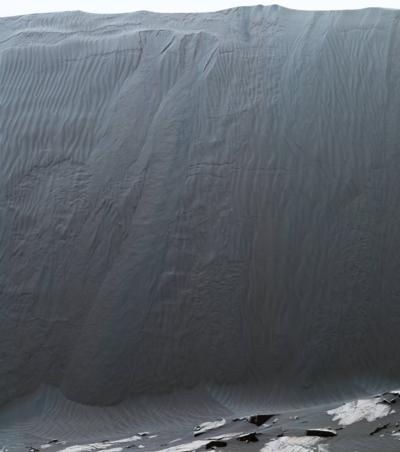Fri, Jan 08, 2016
Observes Slip Face Of Dune For The First Time
NASA's Curiosity Mars rover, partway through the first up-close study ever conducted of extraterrestrial sand dunes, is providing dramatic views of a dune's steep face, where cascading sand has sculpted very different textures than the wavy ripples visible on the dune's windward slope.

Researchers are using Curiosity to examine examples of the Bagnold Dunes, a band of dark sand dunes lining the northwestern flank of Mt. Sharp, the layered mountain the rover is climbing. A characteristic that sets true dunes apart from other wind-shaped bodies of sand, such as drifts and ripples previously visited by Mars rovers, is a steep, downwind slope known as the slip face. Here, sand blowing across the windward side of the dune suddenly becomes sheltered from the wind by the dune itself. The sand falls out of the air and builds up on the slope until it becomes steepened and flows in mini-avalanches down the face.
The mission's dune-investigation campaign is designed to increase understanding about how wind moves and sorts grains of sand, in an environment with less gravity and much less atmosphere than well-studied dune fields on Earth. The Bagnold Dunes are active. Sequential images taken from orbit over the course of multiple years show that some of these dunes are migrating by as much as a yard, or meter, per Earth year.
Curiosity has not caught a sand slide in action, but the rover's images of the Namib Dune slip face show where such slides have occurred recently. These dunes likely are most active in Mars' southern summer, rather than in the current late-fall season.

A few days of rover operations were affected in December due to an arm-motion fault, diagnosed as a minor software issue. Normal use of the arm resumed Dec. 23.
Curiosity has been working on Mars since early August 2012. It reached the base of Mount Sharp in 2014 after fruitfully investigating outcrops closer to its landing site and then trekking to the mountain. The main mission objective now is to examine successively higher layers of Mount Sharp.
(Images provided with NASA news release)
More News
Airplane Bounced About 3 Ft Then Touched Back Down And Then, With No Brakes Applied, The Airplane Began Veering To The Left Analysis: The pilot entered the airport traffic pattern >[...]
Aero Linx: British Microlight Aircraft Association (BMAA) The primary focus within all aviation activity is SAFETY. In all aspects of our sport SAFETY must come first, whether it b>[...]
From SnF25 (YouTube Edition): William Wynne Builds Practical Aircraft Engines on the Corvair Platform Seeking an affordable alternative to the traditional aircraft engine options, >[...]
How To Get A Story On Aero-TV News/Feature Programming How do I submit a story idea or lead to Aero-TV? If you would like to submit a story idea or lead, please contact Jim Campbel>[...]
From 2023 (YouTube Edition): Bridge of CiES CiES Inc. is a Bend, Oregon-based designer and manufacturer of modular embedded aircraft systems and sensors. The company’s fuel-l>[...]
 NTSB Final Report: Aviat A1
NTSB Final Report: Aviat A1 ANN's Daily Aero-Linx (07.08.25)
ANN's Daily Aero-Linx (07.08.25) Classic Aero-TV: Fly Corvairs Reliable Engine Alternative
Classic Aero-TV: Fly Corvairs Reliable Engine Alternative ANN FAQ: Contributing To Aero-TV
ANN FAQ: Contributing To Aero-TV Classic Aero-TV: CiES Fuel-Quantity and e-Throttle Systems Praised
Classic Aero-TV: CiES Fuel-Quantity and e-Throttle Systems Praised




